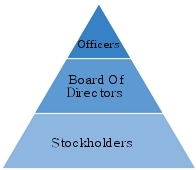
Before 1977, if you wanted to register a business entity, you could choose to be either a partnership or a corporation. A corporation offered liability protection but was considered too complicated and cumbersome to manage properly and had less favorable tax treatment for most small businesses. Partnership, on the other hand, offered better tax treatment, simplified management but no liability protection. So, in 1977, the small business world changed with the introduction of the first Limited Liability Company (LLC) in Wyoming.
The first efforts to form LLCs were hampered by IRS rulings, stating that LLCs looked too much like corporations. The IRS felt that businesses would form an LLC just to escape corporate taxes. After several years, the promoters of the LLC concept and the IRS came up with a compromise to solve the taxing problems.
By definition, corporations have six characteristics:
- Associates
- The objective of running a business and dividing the gains
- Limited liability
- Centralized management
- Free transferability of interest
- Continuity of life
All businesses, except for sole proprietors and single-member LLCs, have associates which are the shareholders in a corporation, partners in a partnership, and members in an LLC. Moreover, all businesses have an objective to carry on business and divide the gains between the associates. So, as a compromise, the IRS looked at the four remaining characteristics and said that, for an LLC to be taxed as a pass-through entity and not as a corporation, it could only incorporate two of the remaining four characteristics. The LLC could determine which of the four characteristics it wanted.
When a firm chooses one of the four remaining characteristics, it gets a check in its “corporate-like” box. Having too many “corporate-like” boxes checked the IRS will say that you look too much like a corporation and tax you as one. Assuming the LLC is properly formed so that it does not look too much like a corporation, it will be treated as a partnership for tax purposes by the IRS.
Let’s look at the four remaining characteristics to help you choose which two are the most important for your LLC.
Liability Protection
As a general rule, members of an LLC are not liable for wrongdoing committed in the scope of normal business (tort liability) nor are they liable to third parties for contracts made by the firm regardless of the owner’s level of participation (contract liability). This is why nearly every LLC checks liability protection as one of its four characteristics in its “corporate-like” box. However, liability protection is not all-encompassing. So, let’s break down tort and contract liability and introduce a rather unique protection afforded to LLCs.
Tort Liability
What is tort liability? One of the most common forms of tort liability in an LLC is due to negligence. By definition, negligence is a failure to act with the level of care that a reasonable person would use under the same circumstances. Your LLC will protect your personal assets from tort liability, as long as you are not the person who committed the act.
For example, if an employee of your LLC commits a wrongful act, they can be held personally liable for the consequences of their conduct. A person is always liable for their own acts or omissions constituting gross negligence, intentional misconduct, or knowingly violating the law.
In addition, members or managers of the LLC may also be personally liable if, in their individual capacities, they damage someone else’s contractual or business relationship. For example, if a member makes a down payment to purchase real estate under a contract of the LLC using a personal check, and that check bounces, they are personally liable for the bad check.
Managers of an LLC (as opposed to non-manager members) represent a special type of oversight/governance position in an LLC, kind of like a director in a corporation. Even if a manager of an LLC is not participating “hands-on” in every step, they may be held personally liable for misconduct. This liability is not based solely on their membership in the LLC but rather on the fact that they are present and participating in the operations of the company while a violation was being committed, either by them or the company. The LLC’s non-manager members, by virtue of the fact that they are not managers, are not considered liable. So, if an employee commits an act that would trigger a tort liability without the approval or knowledge of the member, the member should remain immune from any liability by the LLC.
Managers of an LLC are held to a high standard when dealing with other members in the LLC, owing to the fact that they have a fiduciary duty to the other members. Therefore, managers of an LLC may be held personally liable for approving, directing, actively participating in, or contributing to the company’s negligent conduct.
Contract Liability
What is contract liability? Contract liability is an obligation of the LLC to fulfill the terms of a contract. In most cases, contract liability falls into two camps, service and debt liability.
Service Contract Liability
If a customer pays for a product or service and the deliverable is deemed unacceptable and the company refuses to remedy the problem, this is considered a form of contract liability. To protect yourself personally, you need to always sign contracts in the name of, and as an agent of the LLC to help ensure protection from contractual liability. Generally, a contract signed by the LLC on behalf of the LLC manager(s) does not expose an owner/member to personal liability. However, this is only true if the contract does not require a personal guarantee, which brings us to debt contract liability.
Debt Contract Liability
When it comes to debts owed by the LLC, in nearly every case, the members will have to sign personal guarantees to the creditor, thereby overriding much of the debt-related contract liability protection of the LLC. Unless the business has a huge amount of free cash in the bank, no creditor will ever loan money to an LLC if there is any risk of not getting their principal back. While the LLC may die an untimely death, the members will live on. Creditors want the ability to go after the members even if the business no longer exists, which is why they require personal guarantees from some or all of the members.
Charging Order Protection
One overlooked protection offered by an LLC is protection from charging orders. So, what is a charging order? Typically, when a creditor is not paid by a borrower, they take the borrower to court. The first step is to get a judgment from the court stating that the borrower has an obligation to pay the debt. The next step is for the creditor to ask the court for an order that secures the debt against a person’s assets such as their home or other property. This is known as a “charging order”. With a charging order, the creditor can ask the court to either seize the assets or force the person to liquidate their assets to cover the debt.
Let’s say that a member of your LLC incurs a personal debt outside of their relationship with the LLC, and the courts approve a charging order. While the charging order gives a creditor the right to a member’s distribution paid by the LLC, it does not give the creditor any right to affect the management of the business entity that the member is part of.
Imagine the chaos if a member’s creditor could seize a member’s interest in the LLC, then the creditor would become a member in the LLC and could hijack the LLC. Moreover, if a creditor could force the LLC to sell some or all of the LLC’s assets to cover a charging order against one of its members, the LLC would be destroyed by the creditor and that would be very unfair to the other members. As a result, one of the biggest forms of liability protection afforded by an LLC is the protection of the other members from charging orders.
Since “Limited Liability” for its members is pretty much a given, the LLC will essentially have only one choice left among centralized management, free transferability of interest, or continuity of life if it does not want to receive the tax treatment of a corporation.
Centralized Management
What is centralized management? Essentially, centralized management pertains to the LLC’s choice to be either a member-managed or a manager-managed organization. To get a better understanding of the issue of centralized management, let’s look at how a corporation is managed.

In a corporation, the shareholders vote for the directors who in turn elect the officers of the corporation. Officers such as the Chief Executive Officer (CEO) or the President do not have to be shareholders of the corporation, although many are provided stock or at least stock options as part of their compensation. Therefore, corporations are said to have centralized management since the managers do not have to be owners or shareholders. Instead, the management of a corporation is centralized with the officers and directors and not the stockholders.
Member-Managed
In a member-managed LLC, all members participate in the decision-making process of the LLC. As a result, they accept additional culpability when it comes to tort liability. Each member is an agent of the LLC and each member has a vote in major business decisions. Decisions are generally made by consensus during what are called Special Meetings of the Members where resolutions are adopted and recorded in the LLC minute book. Each member has the authority to make decisions on behalf of the company in their area of expertise, but contracts and loan agreements must be approved by a majority of the members.
When it comes to LLCs, member-managed is the most popular option. This is because in most cases, the members have an economic stake in the business and want to have a say in its direction.
Manager-Managed
In a manager-managed LLC, the authority to manage the operations is vested in a manager. The manager may be a member of the LLC but does not have to be. The manager becomes an agent of the company based on his title as a manager and not by being an owner or member of the LLC. The manager of an LLC may be a person, another LLC, or a corporation unless the state sets restrictions on the types of entities that may be managers of an LLC.
Below are several examples of when it makes more sense to be a manager-managed LLC than a member-managed LLC.
Silent Partner – You can have a silent partner, such as a relative who is putting in money but wants no part of the LLC management for additional liability protection. Silent partners are individual investors and designated as members, but since they do not participate in the decision-making of the company, they are passive members that have less liability exposure.
Large LLCs – In larger LLCs, it makes sense to select one or more managers to run the business, since it would be difficult to try to get all the members together to make decisions. The members can then focus on their area of expertise or the work they want to do. Employing a hired gun that is a professional manager is a good choice for larger LLCs because the management of the LLC is much more complex.
Outsourced Management – Some LLCs simply hold assets such as property in an LLC. Often, owners of investment properties will have many LLCs, each with a single property. This strategy takes maximum advantage of limited liability provision since each property is compartmentalized in a separate entity. In some cases, the day-to-day management of these properties is outsourced to a separate trusted operating or management company.
In my case, we have several LLCs. Each LLC holds the title to one rental income property. So as not to have a separate bank account for each entity, we established a separate paymaster management LLC that acts as the manager for all the other entities. The single paymaster management LLC collects rent and pays all expenses for each of the LLCs that hold the properties. The ownership of each LLC is held by my wife and me. As such, we constitute the total members of the LLC. Except for the paymaster management LLC, which is a member-managed entity, all the LLCs that hold the title to rental income properties are manager-managed and vest the management in the separate paymaster management entity. The paymaster management entity is the designated manager but has no ownership stake and therefore is not a member of the entities that hold the title to the properties.
IRA as Member – Another reason many choose to have a manager-managed LLC is if they place an IRA into an LLC to use it as an investment vehicle. Since the IRA is technically not a member that can make decisions, the LLC can’t be member-managed.
The Election
In most states when you register a new entity, the originator elects to have the management of the LLC vested in either members or managers.
The LLC’s operating agreement will state the rights and duties of the managers and document the initial slate of managers. When the operating agreement lists that the members will be the managers, then you do not have centralized management and you are free to pick one of the other characteristics and not add your second check in the “corporate-like” box.
Free Transferability of Interest
What is meant by transferability of interest? Transferability refers to the right to transfer all or part of a member’s interest without needing the consent or permission of any of the other members.
Transferability is a key feature of a publicly-traded company. When you own shares in Walmart, you do not need the permission of all the other shareholders or Walmart to sell your shares. This is what is meant by free transferability of interest.
LLCs by contrast are generally closely held entities where all the members know each other in some way. It is not in the interest of the LLC or its members to allow any member to simply and freely sell their interest to anyone without the consent of the other member. This is especially true if it is member-managed.
For example, let’s assume that one of the members has a falling out with the business and wants to leave. You would not want to allow the member to sell their interest to a competitor, would you? Therefore, most LLCs add language to their operating agreement to limit the free transferability of a member’s interest.
Generally, the LLC will include language in their operating agreement to the effect that all members must unanimously consent to any transfer. Such a provision prevents a member from freely transferring their interest and therefore does not check the “corporate-like” box. However, the limits on the free transfer of interest make any investment in the LLC less liquid and therefore a less desirable investment vehicle for many investors.
If the LLC operating agreement allows a member to transfer their interest with the consent of the majority only, thus satisfying the requirement that interests are not freely transferable, we get into the question of how to define “majority”. Does a majority mean the number of members or the value of their membership – which are hard to quantify in an LLC?
Since free transferability of interest is often not a critical characteristic of a more closely held LLC, the trick is to limit free transferability of interest enough to pass the test of not being a corporation, but not limit transferability to the point of making it really difficult to divest oneself of the interest if desired.
If you want free transferability of interest, an LLC is likely not the best entity, and it might be better to choose a corporation that issues stocks to owners instead.
Continuity of Life
What is meant by continuity of life? Continuity of life means that the LLC will continue to exist in the event that one of the members either dies, is deemed insane, goes bankrupt, retires, resigns, or is expelled. Such an event by any member without a continuity of life provision in the LLC operating agreement will cause an automatic dissolution of the organization unless the rest of the members unanimously agree in a Special Meeting of the Members to continue operations without the member within 90 days.
Under the default statutes, the LLC does not have continuity of life unless it is specifically stated in the operating agreement.
Some states provide opportunities for more flexibility regarding the “unanimous” consent part. In some states, it is enough if a “majority in interest” of the remaining members agreed to continue the business. According to the Securities and Exchange Commission (SEC) “majority in interests” means, at any given time, members who (i) hold in the aggregate more than fifty percent (50%) of the profits interest held by all Members and (ii) hold in the aggregate more than fifty percent (50%) of the capital interests held by the Members, as determined on the basis of positive Capital Account balances of the Members. If all of the Capital Account balances are zero or negative, the majority in interest shall be determined by profits interest.
In many corporations, continuity of life is a critical characteristic since they often have many shareholders, and it would be impractical to have a vote to continue operations if one of them leaves. However, continuity of life in an LLC is often less problematic, unless it is a very large LLC since they often have fewer members and all it takes is a vote to continue operations within 90 days of the member leaving. Moreover, by default, an LLC has no continuity of life, so, unless the members expressly want continuity of life and include a provision to that effect in their operating agreement, this is an easy characteristic to ignore so as not to check the “corporate-like” box.
Is your LLC compliant?
Business & Finance Articles on Business 2 Community
(44)







